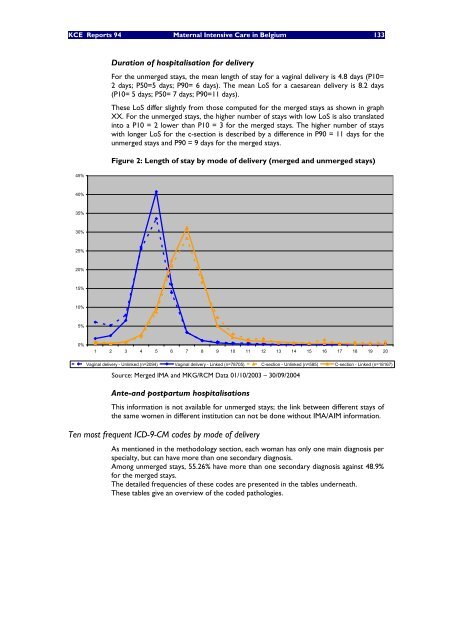Soins maternels intensifs (Maternal Intensive Care) en Belgique - KCE
Soins maternels intensifs (Maternal Intensive Care) en Belgique - KCE
Soins maternels intensifs (Maternal Intensive Care) en Belgique - KCE
You also want an ePaper? Increase the reach of your titles
YUMPU automatically turns print PDFs into web optimized ePapers that Google loves.
<strong>KCE</strong> Reports 94 <strong>Maternal</strong> <strong>Int<strong>en</strong>sive</strong> <strong>Care</strong> in Belgium 133<br />
45%<br />
40%<br />
35%<br />
30%<br />
25%<br />
20%<br />
15%<br />
10%<br />
5%<br />
0%<br />
Duration of hospitalisation for delivery<br />
For the unmerged stays, the mean l<strong>en</strong>gth of stay for a vaginal delivery is 4.8 days (P10=<br />
2 days; P50=5 days; P90= 6 days). The mean LoS for a caesarean delivery is 8.2 days<br />
(P10= 5 days; P50= 7 days; P90=11 days).<br />
These LoS differ slightly from those computed for the merged stays as shown in graph<br />
XX. For the unmerged stays, the higher number of stays with low LoS is also translated<br />
into a P10 = 2 lower than P10 = 3 for the merged stays. The higher number of stays<br />
with longer LoS for the c-section is described by a differ<strong>en</strong>ce in P90 = 11 days for the<br />
unmerged stays and P90 = 9 days for the merged stays.<br />
Figure 2: L<strong>en</strong>gth of stay by mode of delivery (merged and unmerged stays)<br />
1 2 3 4 5 6 7 8 9 10 11 12 13 14 15 16 17 18 19 20<br />
Vaginal delivery - Unlinked (n=2094) Vaginal delivery - Linked (n=78705) C-section - Unlinked (n=585) C-section - Linked (n=18167)<br />
Source: Merged IMA and MKG/RCM Data 01/10/2003 – 30/09/2004<br />
Ante-and postpartum hospitalisations<br />
This information is not available for unmerged stays; the link betwe<strong>en</strong> differ<strong>en</strong>t stays of<br />
the same wom<strong>en</strong> in differ<strong>en</strong>t institution can not be done without IMA/AIM information.<br />
T<strong>en</strong> most frequ<strong>en</strong>t ICD-9-CM codes by mode of delivery<br />
As m<strong>en</strong>tioned in the methodology section, each woman has only one main diagnosis per<br />
specialty, but can have more than one secondary diagnosis.<br />
Among unmerged stays, 55.26% have more than one secondary diagnosis against 48.9%<br />
for the merged stays.<br />
The detailed frequ<strong>en</strong>cies of these codes are pres<strong>en</strong>ted in the tables underneath.<br />
These tables give an overview of the coded pathologies.

















